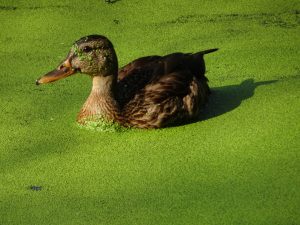Some people look at a quiet pond covered with bright green duckweed and think “How pretty that is! And the ducks love it!” Others, your writer among them, look at it and think “Eeewww, it sticks to your ankles!” Here we have a very simple plant with a complicated story. Some sources say it’s very good for ponds but others say it’s bad for ponds. How does such a small plant get such different reactions?
Even scientists can’t always agree about duckweed. They generally think there are 30 species but can’t decide if duckweed has 4 or 6 genera (genuses) . Botanists do agree that duckweed is related to skunk cabbage, calla lilies, jack-in-the-pulpit, and other plants in the Arum family.
The part of duckweed that we see is only a few cells thick, usually with an air space in it to keep it floating at the surface or just underneath. It doesn’t have standard leaves, stems, or roots. It usually reproduces by budding but occasionally will put out microscopic flowers that will create seeds. Some species have very simple rootlets, others are without.
Duckweed grows best in still or barely moving water, and prefers fertile or even overly fertile waters. It grows fastest in spring and fall but stops growing in the heat of summer. When it starts to freeze, the plants sink to the bottom and make buds which rise again in spring to start a new generation. It can move to new places by either clinging to feet, fur, or feathers of animals or people in the pond, or by being washed along by a sudden flow of water (think rainstorms).
What’s the problem with duckweed? It grows really fast and is hard to fully eradicate. Duckweed grows so quickly that it can double in area covered in 3 to 4 days. It is not particularly good at oxygenating ponds – submerged plants like eelgrass are better at adding oxygen. If duckweed is growing in a pond or waterway with a low nutrient level, it will tend to soak up a large share of whatever nutrients are available. Also, if duckweed is left to entirely cover a pond for a long time it will shade out submerged plants and lead to oxygen depletion and fish die-off.
What is duckweed good for? It’s a favorite food for fish, ducks and birds, beavers, and muskrats. Have you ever watched ducks gobbling duckweed as fast as they can? They are happy ducks! Duckweed also provides shelter and shade for frogs, fish, and aquatic fry. It shades out algae growth and reduces evaporation from ponds by covering the surface. It is used as a high protein food (higher than soybeans!) by people in Asia.
Beyond these obvious uses, duckweed may be used in the future for water purification, especially to remove phosphates and nitrates, or in municipal wastewater treatment. Further, scientists in Switzerland are starting to experiment with cleaning excess farm runoff in waterways by growing duckweed then harvesting it for animal feed or fertilizer. Finally, duckweed could also be used to blanket ponds for mosquito prevention or as an inexpensive biofuel source since it produces 5 to 6 times as much starch as corn or other sources. Pretty good for such a small plant!

